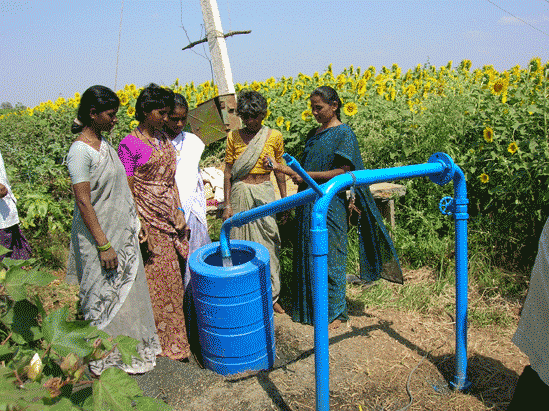Friday, April 19, 2024
News and Views from the Global South
Opinion
Groundwater Governance in Andhra Pradesh

Sustainable groundwater utlisation is critical to rural livelihoods. Credit: FAO, Bharathi Integrated Rural Development Society
- India is the largest user of ground water in the world. But reliance of this overexploited resource has reached its limits in many parts of the country. Nowhere is this more evident than in the drought-prone districts of Rayalseema, uplands of Prakasam, Krishna, East-West Godavari, parts of Nellore, Vizianagaram and Srikakulam in the state of Andhra Pradesh (AP). Forty per cent of the state’s irrigation needs are met through groundwater. In the drought-prone Rayalseema region – which comprises Chittoor, Anantapur, Kurnool, Prakasam and Kadapa districts — dependence on groundwater for irrigation is particularly high. The water crisis is also most severe in this region.
In Rayalaseema, groundwater-linked irrigation has become an unviable source for many small farmers. There has been a sharp decline in groundwater levels, which has affected the livelihood system, food security and nutrition of the farmers. In Chittoor and Anantapur, groundwater levels in fact have reached a critical point making well-failure a common occurrence. Drilling depths in Chittoor district (Ramasamudram and its neighbourhood) averages 1,200 feet, with energising and pipeline costs touching Rs 650,000. As much as 90 percent of drilled wells fail or do not yield any water. In Anantapur, 95 per cent of the newly drilled wells reportedly fail.
Lakhs of wells have either dried up or become un-operational because of deteriorating quality or due to high level of inefficiency. Such failures are likely to increase over time and can emerge as a major economic, societal and environmental concern. It is a no-brainer that drying up of a bore-well impacts food production, leads to loss of livelihood for several dependent families, causes indebtedness and leaves behind a hole in the ground that can be a potential source for contamination. In Prakasam, Kurnool and Anantapur districts, and in coastal areas and major cities and towns, groundwater contamination is fast expanding to new areas and there is environmental degradation.
To address this critical issue elsewhere in India, the Food and Agriculture Organization of the United Nations (FAO) led initiative — Andhra Pradesh Groundwater Systems (APFAMGS) — implemented in five districts of AP deserves serious consideration. APFAMGS provides an ideal framework for designing new decentralised strategies to initiate local self-governance for effective and sustainable management of groundwater resources. AP believes that the prevailing drought and the associated groundwater distress offer an opportunity to use the APFAMGS model for designing new de-centralised strategies. This improves groundwater management and incomes of small and marginal farmers.
FAO and its local partners implemented a very successful APFAMGS project in drought-prone districts of Rayalseema and Mahbubnagar and Nalgonda districts in the newly constituted state of Telengana APFAMGS developed a participatory hydrological monitoring programme to build farmers capacities with the requisite knowledge, data and skills to understand the hydrology of groundwater resources. The project facilitated formation of Groundwater Monitoring Committees—638 farmer committees at the village-level that monitored groundwater resources. These committees were then federated into 63 Hydrological Unit Networks at the hydrological unit level.
Groundwater Monitoring Committees in each hydrological unit estimated the total groundwater resource available and worked out appropriate cropping systems that matched with water availability. The Committees then disseminated the information to the entire farming community within each hydrological unit and acted as pressure groups. It encouraged appropriate water saving and harvesting projects, promoted low investment organic agriculture and helped formulate rules that would ensure inter-annual sustainability of limited groundwater resources. In a majority of the pilot project area (638 villages across seven districts)., the results have been very positive.
The success of this initiative has been noted in World Bank’s Study and Technical Assistance Initiative on Groundwater management in India:
“APFAMGS presents an instructive case study in the “how-to-do” of community-based groundwater management, with its emphasis on participatory rather than passive information gathering, use of non-formal means of education, attention to capacity building and social mobilization rather than physical solutions, generation of a culture of empowerment through engagement of all segments of the community, and respect for armers’ ability to process crucial information of direct relevance to them…. The reductions in groundwater draft in APFAMGS are not coming from altruistic collective action, but from the individual risk management and profit-seeking decisions of thousands of farmers. This makes the APFAMGS model robust and replicable, as no authoritative leadership is required for enforcement of compacts. A major lesson, therefore, is that community-based groundwater management need not require sacrifice.”
The FAO evaluation report on the APFAMGS project said that:
“APFAMGS experience is a breakthrough in the management of groundwater and in securing livelihoods of poor farmers in India: since both are key concerns of the central Government of India and of many State Governments, the approach should be adopted and mainstreamed in the Government’s policy and development work.”
Based on the successful experience in using informal grassroots organization, the Government of Andhra Pradesh and FAO recently agreed to expand the pilot that will involve village level Gram Panchayats upfront in governing water resources. This pilot operates with a very limited funding: total estimated budget for this FAO-led initiative is Rs 35,345,300 or about US$ 534,240. Of this, the state government’s share is pegged at Rs 23,778,500 (US$ 359,409). This is mainly for buying equipments for monitoring water levels, including those that are needed for monitoring rural water supply. FAO’s investment has focuses more on the ‘softer’ side such as hiring village level co-ordinators, farmer’s training, expert consultancy and administrative support and is estimated at about Rs 11,566,800 or US$ 174,831.
Concurrently, FAO is actively looking for partners who are interested in scaling-up the model based on informal organization that has already proven to be effective in managing the demand for fastly depleting groundwater.
* Shyam Bahadur Khadka is FAO’s Representative in India

 Print
Print



